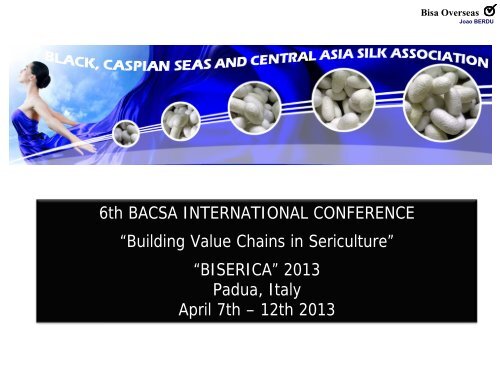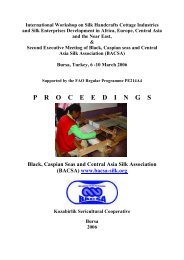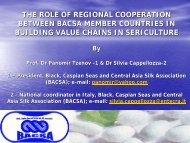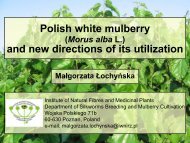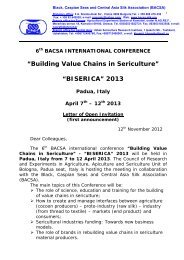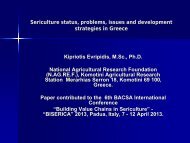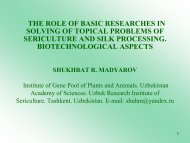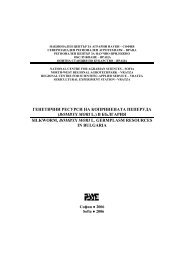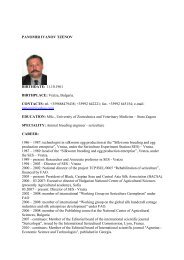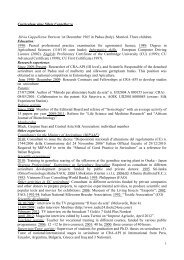Silk Production in Latin America - BACSA
Silk Production in Latin America - BACSA
Silk Production in Latin America - BACSA
You also want an ePaper? Increase the reach of your titles
YUMPU automatically turns print PDFs into web optimized ePapers that Google loves.
<strong>Silk</strong> <strong>Production</strong> <strong>in</strong> Lat<strong>in</strong> <strong>America</strong><br />
Bisa Overseas<br />
Joao BERDU<br />
6th <strong>BACSA</strong> INTERNATIONAL CONFERENCE<br />
“Build<strong>in</strong>g Value Cha<strong>in</strong>s <strong>in</strong> Sericulture”<br />
“BISERICA” 2013<br />
Padua, Italy<br />
April 7th – 12th 2013
<strong>Silk</strong> <strong>Production</strong> <strong>in</strong> Lat<strong>in</strong> <strong>America</strong><br />
Bisa Overseas<br />
Joao BERDU<br />
SERICULTURE IN LATIN AMERICA<br />
Goal of Governments through out the years<br />
Development of poor regions<br />
None has succeded<br />
High asset specificity<br />
Barriers to newcomers
<strong>Silk</strong> <strong>Production</strong> <strong>in</strong> Lat<strong>in</strong> <strong>America</strong><br />
Bisa Overseas<br />
Joao BERDU<br />
SERICULTURE IN LATIN AMERICA<br />
Mexico<br />
Colombia<br />
Ecuador<br />
Peru<br />
Cuba<br />
Venezuela<br />
Bolivia<br />
Brazil<br />
Paraguay<br />
‣ Efforts on sericulture cont<strong>in</strong>ues<br />
‣ Cooperative network<br />
‣ Overcome obstacles<br />
Argent<strong>in</strong>a
Institutional <strong>Silk</strong> <strong>Production</strong> aspects <strong>in</strong> rul<strong>in</strong>g Lat<strong>in</strong> <strong>America</strong><br />
sericulture<br />
Bisa Overseas<br />
Joao BERDU<br />
‣ <strong>Silk</strong> production has many fasc<strong>in</strong>at<strong>in</strong>g and unique aspects<br />
‣ Same <strong>in</strong>stitutional rules of other <strong>in</strong>dustrial activities<br />
SUPPY AND DEMAND RULE
Institutional <strong>Silk</strong> <strong>Production</strong> aspects <strong>in</strong> rul<strong>in</strong>g Lat<strong>in</strong> <strong>America</strong><br />
sericulture<br />
Bisa Overseas<br />
Joao BERDU<br />
COMPETITIVENESS:<br />
‣ Existence of suppliers, distributors and competitive customers.<br />
In silk words:<br />
feedback<br />
Farmer produces<br />
cocoons<br />
Filature buys<br />
sells<br />
cocoon<br />
yarn<br />
feedback<br />
Weav<strong>in</strong>g mill<br />
... and it goes on up to end user.
Institutional <strong>Silk</strong> <strong>Production</strong> aspects <strong>in</strong> rul<strong>in</strong>g Lat<strong>in</strong> <strong>America</strong><br />
sericulture<br />
Bisa Overseas<br />
Joao BERDU<br />
ASSET SPECIFICITY<br />
In silk words: ‣ Capacity to use equipments or knowledge for other purposes;<br />
Cocoon reel<strong>in</strong>g<br />
mach<strong>in</strong>e<br />
‣ Higher specificity means lower value to other uses.<br />
Cocoon<br />
Silworm rear<strong>in</strong>g<br />
knowledge
Institutional <strong>Silk</strong> <strong>Production</strong> aspects <strong>in</strong> rul<strong>in</strong>g Lat<strong>in</strong> <strong>America</strong><br />
sericulture<br />
Bisa Overseas<br />
Joao BERDU<br />
BARRIERS TO ENTRY<br />
‣ Tra<strong>in</strong><strong>in</strong>g of qualified human resources;<br />
‣ Economies of scale and high <strong>in</strong>itial <strong>in</strong>vestment.<br />
In silk words:<br />
<strong>Silk</strong> filature needs<br />
tra<strong>in</strong>ed workers<br />
Cont<strong>in</strong>uous<br />
cocoon demand<br />
supply<br />
Tra<strong>in</strong>ed farmers
World cocoon silk production<br />
<strong>Silk</strong> <strong>Production</strong> Year <strong>in</strong> 2010<br />
Lat<strong>in</strong> <strong>America</strong><br />
Bisa Overseas<br />
Joao BERDU<br />
789.313 Tons
<strong>Silk</strong> <strong>Production</strong> <strong>in</strong> Lat<strong>in</strong> <strong>America</strong><br />
Bisa Overseas<br />
Joao BERDU<br />
Red And<strong>in</strong>a de la Seda / Red Lat<strong>in</strong>oamericana de la Seda<br />
- Settled <strong>in</strong> 2001 -<br />
Seri-farmers, artisans and production of silkworm cocoons at countries of<br />
Red Lat<strong>in</strong>oamericana de la Seda<br />
Year 2010<br />
Country<br />
Number of Number of<br />
Cocoon<br />
TOTAL<br />
artisans Seri-farmers<br />
production (kg)<br />
%<br />
ARGENTINA 15 30 45<br />
BOLÍVIA 12 3 15 42 1%<br />
COLOMBIA 155 180 335 5.175 79%<br />
ECUADOR 25 10 35 517 8%<br />
PERU 49 78 127 794 12%<br />
CUBA 2 2<br />
GUATEMALA 10 3 13<br />
TOTAL 266 306 572 6.528 100%<br />
Source: Rede Lat<strong>in</strong>oamericana de la Seda (Cifuentes, 2012)
<strong>Silk</strong> <strong>Production</strong> <strong>in</strong> Lat<strong>in</strong> <strong>America</strong><br />
Bisa Overseas<br />
Joao BERDU<br />
ARGENTINA<br />
2004 Federal law <strong>in</strong>centivize sericulture<br />
2007 State Regulation on Prov<strong>in</strong>ces<br />
Salta, Catamarca, La Pampa and<br />
Misiones<br />
2010 Lack of common goals and<br />
coord<strong>in</strong>ation
<strong>Silk</strong> <strong>Production</strong> <strong>in</strong> Lat<strong>in</strong> <strong>America</strong><br />
Bisa Overseas<br />
Joao BERDU<br />
BOLÍVIA<br />
80 e 90 USAID and World Bank<br />
1990 2 Korean Companies settled down<br />
1997 2 Korean companies closed down<br />
2004 Cooperation wiht IILA<br />
Stop cocoon production
<strong>Silk</strong> <strong>Production</strong> <strong>in</strong> Lat<strong>in</strong> <strong>America</strong><br />
Bisa Overseas<br />
Joao BERDU<br />
COLÔMBIA<br />
Late 80s: Raw silk high prices on <strong>in</strong>ternational<br />
market<br />
Two Korean jo<strong>in</strong>t ventures :<br />
COKOSILK S.A <strong>in</strong> the city of Pereira<br />
COSEDAS <strong>in</strong> Popayan<br />
1992 Cosedas is closed down and Cokosilk<br />
changes its project.<br />
1993 ECU agreement 1.500 ha mulberry<br />
1998 ECU cancels agreement<br />
2000 Corseda is settled<br />
2012 170 seri-farmers and 120 artisans
<strong>Silk</strong> <strong>Production</strong> <strong>in</strong> Lat<strong>in</strong> <strong>America</strong><br />
Bisa Overseas<br />
Joao BERDU<br />
CUBA<br />
2004 Experimentation starts at Indio<br />
Hatuey Station<br />
2006 High quality cocoon can be<br />
produced <strong>in</strong> small scale<br />
2012 Decease problems as a reason to<br />
small development, but project<br />
cont<strong>in</strong>ues aim<strong>in</strong>g production for<br />
tourists.
<strong>Silk</strong> <strong>Production</strong> <strong>in</strong> Lat<strong>in</strong> <strong>America</strong><br />
Bisa Overseas<br />
Joao BERDU<br />
EQUADOR<br />
2010 517 kg of cocoon produced<br />
10 seri-farmers and 25 artisans<br />
2004 500 farmers tra<strong>in</strong>ed and<br />
110 ha of mulberry trees planted
<strong>Silk</strong> <strong>Production</strong> <strong>in</strong> Lat<strong>in</strong> <strong>America</strong><br />
Bisa Overseas<br />
Joao BERDU<br />
MÉXICO<br />
1991 National Sericulture Program<br />
2009 <strong>Silk</strong>worm distribution <strong>in</strong> the regions of<br />
Sierra Norte, Valle Central and Mixteca<br />
1995<br />
to<br />
2012 Distribution of more than 15.000.000<br />
heads of silkworm<br />
30 tons of cocoon <strong>in</strong> 17 years
<strong>Silk</strong> <strong>Production</strong> <strong>in</strong> Lat<strong>in</strong> <strong>America</strong><br />
Bisa Overseas<br />
Joao BERDU<br />
PARAGUAI<br />
1988 Seda y Fibras Srl.<br />
2003 National de Sericulture Program<br />
‣ Alternative to small farms<br />
‣ optimize use of resources<br />
‣ create partnerships<br />
2011 Seda y Fibras signs cooperation<br />
agreement with state University<br />
<strong>in</strong> Brazil to ma<strong>in</strong>tenance of parent<br />
races and hybrids production
<strong>Silk</strong> <strong>Production</strong> <strong>in</strong> Lat<strong>in</strong> <strong>America</strong><br />
Bisa Overseas<br />
Joao BERDU<br />
PERU<br />
2005 National Law to support sericulture<br />
as alternative to coca cultivation<br />
2006 10 ha of mulberry trees<br />
50 seri-farmers<br />
10 artisans<br />
500 m2 to 2,0 ha<br />
2008 Protocol between Peru and Ch<strong>in</strong>a<br />
to plant 14.000 ha of mulberry<br />
trees.
<strong>Silk</strong> <strong>Production</strong> <strong>in</strong> Lat<strong>in</strong> <strong>America</strong><br />
Bisa Overseas<br />
Joao BERDU<br />
VENEZUELA<br />
Sericulture starts <strong>in</strong> middle XIX century<br />
1983 Veneseda is settled<br />
1990 Cocoon production started and was<br />
aborted few years later<br />
2012 Few farmers produc<strong>in</strong>g to Veneseda<br />
2012 Cooperation with IILA - Istituto<br />
Italo-Lat<strong>in</strong>o <strong>America</strong>no: Torcitura<br />
di Domaso donates a twist<strong>in</strong>g<br />
mach<strong>in</strong>e to Veneseda
<strong>Silk</strong> <strong>Production</strong> <strong>in</strong> Lat<strong>in</strong> <strong>America</strong><br />
Bisa Overseas<br />
Joao BERDU<br />
BRASIL<br />
1850 Sericulture starts D. Pedro II<br />
1920 Japanese immigration <strong>in</strong>creases<br />
1940 Filature Bratac starts production<br />
1992 6 silk filatures<br />
19.134 tons of cocoon produced<br />
2012 Bratac is the sole silk reel<strong>in</strong>g<br />
company <strong>in</strong> Brazil<br />
Bratac’s raw silk has the reputation of<br />
be<strong>in</strong>g the best one <strong>in</strong> the market.
<strong>Silk</strong> <strong>Production</strong> <strong>in</strong> Lat<strong>in</strong> <strong>America</strong><br />
Bisa Overseas<br />
Joao BERDU<br />
Brazil is second largest raw<br />
silk exporter <strong>in</strong> the world<br />
Paraná<br />
Paraná 92 % of Brazilian cocoon production
<strong>Silk</strong> <strong>Production</strong> <strong>in</strong> Lat<strong>in</strong> <strong>America</strong><br />
Bisa Overseas<br />
Joao BERDU
<strong>Silk</strong> <strong>Production</strong> <strong>in</strong> Lat<strong>in</strong> <strong>America</strong><br />
Bisa Overseas<br />
Joao BERDU<br />
Brazilian cocoon production and wet cocoon price<br />
(tons and R$)<br />
2005 a 2013*<br />
Source: Bratac – 2012<br />
* Forecast
<strong>Silk</strong> <strong>Production</strong> <strong>in</strong> Lat<strong>in</strong> <strong>America</strong><br />
Bisa Overseas<br />
Joao BERDU<br />
Average price of fresh cocoon paid <strong>in</strong> Brazil<br />
‣ <strong>in</strong> 1989 = US$3,51/kg<br />
‣ 1991 to 2000 = US$2,19/kg<br />
‣ 2001 to 2010 = US$2,51/kg<br />
‣ 2011 / 2012 = US$4,90/kg<br />
‣ 2012 / 2013 = US$5,83/kg<br />
Sources: SEAB-PR, 2010<br />
Bratac (2012)
<strong>Silk</strong> <strong>Production</strong> <strong>in</strong> Lat<strong>in</strong> <strong>America</strong><br />
Bisa Overseas<br />
Joao BERDU<br />
‣ Increas<strong>in</strong>g of cocoon price isn’t t motivat<strong>in</strong>g farmers <strong>in</strong> Brazil<br />
‣Brazilian silk filature has idle capacity<br />
‣International market for Brazilian raw silk is bullish<br />
‣ Development of partnerships
<strong>Silk</strong> <strong>Production</strong> <strong>in</strong> Lat<strong>in</strong> <strong>America</strong><br />
Bisa Overseas<br />
Joao BERDU<br />
‣ Project Vale da Seda, , by Technology Incubator of<br />
Mar<strong>in</strong>ga,<br />
‣ Susta<strong>in</strong>able regional development<br />
‣ Cooperative Artisans Brasil exports scarves to Artisans<br />
Du Monde, <strong>in</strong> France.
<strong>Silk</strong> <strong>Production</strong> <strong>in</strong> Lat<strong>in</strong> <strong>America</strong><br />
Bisa Overseas<br />
Joao BERDU<br />
Conclusion<br />
‣ Federal Government efforts did not succeed so far <strong>in</strong> L.A.<br />
‣ Sericulture creates one job/ha of mulberry trees<br />
‣Brazilian filature works with idle capacity and is very well<br />
positioned <strong>in</strong> the world market<br />
‣Sericulture equipments and know how are specific
<strong>Silk</strong> <strong>Production</strong> <strong>in</strong> Lat<strong>in</strong> <strong>America</strong><br />
Bisa Overseas<br />
Joao BERDU<br />
Conclusion<br />
‣<strong>in</strong>stitutional environment <strong>in</strong> L.A. is favorable to sericulture<br />
‣ Vale da Seda Project: big quantity of cocoon production<br />
can support local <strong>in</strong>itiatives <strong>in</strong> the silk cha<strong>in</strong>.<br />
Cocoon <strong>Production</strong> <strong>in</strong><br />
<strong>in</strong>dustrial scale<br />
Development of local silk<br />
market cha<strong>in</strong>
<strong>Silk</strong> <strong>Production</strong> <strong>in</strong> Lat<strong>in</strong> <strong>America</strong><br />
Bisa Overseas<br />
Joao BERDU<br />
Cocoon production<br />
<strong>in</strong> <strong>in</strong>dustrial scale<br />
Cocoon export to<br />
Brazil<br />
Cocoon export to Brazil<br />
Development<br />
Development<br />
of local silk<br />
of local silk<br />
market cha<strong>in</strong>
<strong>Silk</strong> <strong>Production</strong> <strong>in</strong> Lat<strong>in</strong> <strong>America</strong><br />
Bisa Overseas<br />
Joao BERDU<br />
Conclusion<br />
Is it possible to settle an <strong>in</strong>ternational cooperation<br />
network to support cocoon production cha<strong>in</strong> <strong>in</strong><br />
Lat<strong>in</strong> <strong>America</strong>, based on raw silk production <strong>in</strong><br />
Brazil?
<strong>Silk</strong> <strong>Production</strong> <strong>in</strong> Lat<strong>in</strong> <strong>America</strong><br />
Bisa Overseas<br />
Joao BERDU<br />
Thank you !<br />
Grazie mille !<br />
Carpe diem...


